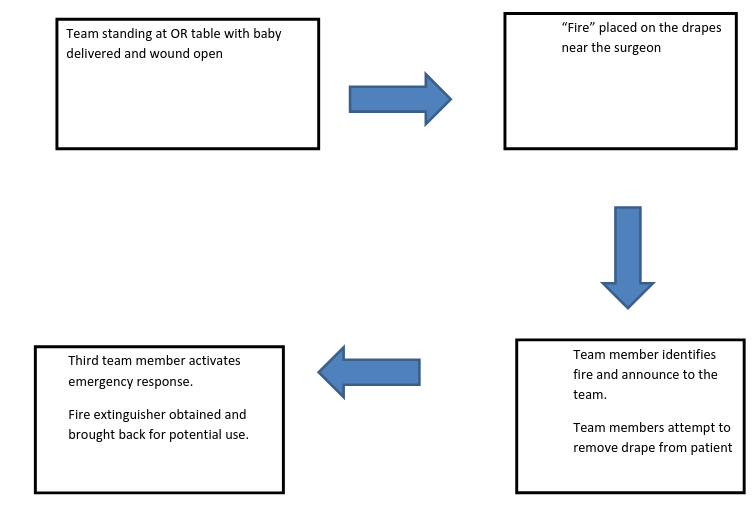|
Page 4 of 9
Sim Corner
Fire in the OR
Vanessa Torbenson
September, 2017
Case summary:
Length 10-15 minutes
Cesarean delivery
Target group: Obstetricians, Anesthesia, Nurses
Team members for the Scenario:
Obstetrician
Anesthesia
Scrub RN
Circulating RN
Patient
Family Member
General Learning Objectives
- Communicate effectively with team using crisis resource management skills
- Communicate an adverse event with a patient and her family
Scenario specific Goals:
- Complete appropriate documentation of fire risk assessment
- Recognize and activate the emergency response system to fire in the OR suite
- Locate the OR suite fire alarms and fire extinguishers
- Demonstrate how to safely extinguish a fire in proximity to a surgical site
- Demonstrate appropriate technique in evacuating an intraoperative patient from the affected surgical suite
- Implement infant security plan
- Employ the SBARR technique to inform and prepare incoming team members for action
Debriefing overview:
- Review sequence of events
- Review learning objectives
- Review communication and team work skills
- What went well?
- What would you do differently next time?
- Share key assessments and learning points with those present and not present.
Patient Case Summary:
June is a 37 y/o G2P1001 who is prepped and draped for a repeat cesarean section due to failed TOLAC. The cesarean delivery category is semi-urgent. The team assembles in the OR and performs the routine preoperative safety checks and the time-out. The case is started as per usual. Shortly after the neonate has been delivered and uterus and fascia, but not the subcutaneous tissue is closed, a fire erupts on the drapes adjacent to the surgeon.
Additional Information:
- Allergies: NKDA
- Medications: PNV
- Ht 5’6
- Weight 170lbs
- EFW 3000g
- PSH Neg
- OB History: Previous C-section x1
- VS HR 85; RR 20; BP 118/70; Temp 37.4
- FHT’s category 2
- GBS unknown
- 1 hour Glucola:110
- Social history negative
Set up: Patient (staff or mannequin) in OR bed with Cesarean delivery drapes placed. Large bright orange flames made out of orange/red felt or construction paper with adhesive tape applied. This is attached to area where flames erupt (Above waist vs below waist)
Equipment:
- OR table
- Cesarean section drapes
- Flames (Bright orange felt or construction paper in shape of flames with adhesive tape)
- Cesarean instruments
- Baby
- Warmer
- Fire Extinguisher
Sequence of Events:

Sequence of Events:
- Responder #1 (Scrub RN)—Identifies emergency and reports fire
- Responder #1/ 2— Calls for removal of drapes
- Responder #2 (OB) Asks for extinguisher to extinguish fire
- Responder #3 (Circulation RN)— retrieval of extinguisher and activation of emergency system
- Responder #4 (Anesthesia) Preparation of patient for removal from OR
- Responder #4 (Charge)— Removal of baby and all other personnel.
1) Drapes to be removed right away if possible
2) Discuss the RACE mnemonic ( Rescue –Alarm- Contain-Extinguish)
4) Discuss the PASS mnemonic ( Pull-Aim-Squeeze-Sweep)
5) Knowledge of activation of fire emergency
6) Knowledge of local fire alarms and extinguishers
7) Examine patient for burns
8) Maintain communication with patient and family
Debrief:
- Implement infant security back up plan (stationing staff at unlocked exit doors)
- What can be used to decrease Fire safety risk
- When does Fire safety risk end
- (Establish psychological safety during introduction to scenario and revisit here)
- Emotions --> Ask “How did that feel?”
- Focus on the performance, not the performer
- Ask “What went well?” and “What would you do differently?”
- Move to practice --> “How could this happen to you?”
Calibrate --> Identify and correct misconceptions
Reference: "Resources and Tools for Preventing Surgical Fires, US, FDA"
|


